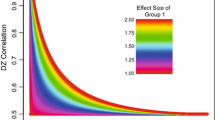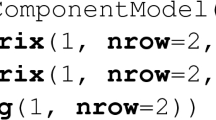Abstract
Covariances between traits can be partitioned into additive and dominance genetic components and between- and within-family environmental components, using a method analogous to that used in the analysis of single traits. The problem arises as to whether all additive genetic components simply reflect a single additive component, in the sense that, given an appropriate rescaling of the breeding values, a single additive genetic component would adequately describe the additive genetic variation. The statistical procedure for testing this hypothesis is discussed in detail. Similar considerations apply to the dominance variation. The approach is applied to twin data given by Loehlin and Vandenberg (1968) on covariation between five of Thurstone's Primary Mental abilities. Although the data do not permit a reliable separation of additive and dominance components, it is shown that a single genetic component will account for almost all the genetic variation and covariation. Unless there is marked linkage disequilibrium, this implies that most of the genetic variation for the five traits can be attributed to the pleiotropic action of genes at a common set of loci.
Similar content being viewed by others
References
Bailey, N. T. J. (1961).Introduction to the Mathematical Theory of Genetic Linkage, Oxford University Press, London.
Eaves, L. J. (1972a). The multivariate analysis of certain genotype-environment interactions.Behav. Genet. 2; 241–244.
Eaves, L. J. (1972b). Computer simulation of sample size and experimental design in human psychogenetics.Psychol. Bull. 77: 144–152.
Eaves, L. J. (1973a). The structure of genotypic and environmental covariation for personality measurements: An analysis of the P.E.N.,Brit. J. Soc. Clin. Psychol. 12: 275–282.
Eaves, L. J. (1973b). Assortative mating and intelligence: An analysis of pedigree data.Heredity 30: 199–210.
Eaves, L. J., and Brumpton, R. J. (1972). Factors of covariation inNicotiana rustica.Heredity 29: 151–175.
Eaves, L. J., and Jinks, J. L. (1972). Insignificance of evidence for differences in heritability of I.Q. between races and social classes.Nature 240:84–88.
Fisher, R. A. (1946). A system of scoring linkage data. with special reference to pied factors in mice.Am. Naturalist 80: 568–578.
Gale, J. S., and Eaves, L. J. (1972). Variation in wild populations ofPapaver dubium. V. The application of factor analysis to the study of variation.Heredity 29: 135–149.
Jinks, J. L., and Fulker, D. W. (1970). A comparison of the biometrical genetical. MAVA. and classical approaches to the analysis of human behavior.Psychol. Bull.,73: 311–349.
Kendall, M. G., and Stuart, A. (1963).The Advanced Theory of Statistics 2nd ed., Vol. 1, Griffin and Company, London.
Loehlin, J. C. (1965). A heredity-environment analysis of personality inventory data. In Vandenberg S. G. (ed.),Methods and Goals in Human Behavior Genetics. Academic Press. New York, pp. 163–170.
Loehlin, J. C., and Vandenberg, S. G. (1968). Genetic and environmental components in the covariation of cognitive abilities: An additive model. In Vandenberg, S. G. (ed.),Progress in Human Behavior Genetics, Johns Hopkins, Baltimore, pp. 261–278.
Mather, K., and Jinks, J. L. (1971),Biometrical Genetics: The Study of Continuous Variation, Chapman and Hall, London.
Roudabush, G. E. (1968). Analyzing dyadic relationships. In Vandenberg, S. G. (ed.),Progress in Human Behavior Genetics, Johns Hopkins Baltimore, pp. 303–333.
Vandenberg, S. G. (1965). Multivariate analysis of twin differences. In Vandenberg, S. G. (ed.),Methods and Goals in Human Behavior Genetics, Academic Press, New York, pp. 29–43.
Author information
Authors and Affiliations
Additional information
This work is part of a project in Psychogenetics supported by the British Medical Research Council.
Rights and permissions
About this article
Cite this article
Eaves, L.J., Gale, J.S. A method for analyzing the genetic basis of covariation. Behav Genet 4, 253–267 (1974). https://doi.org/10.1007/BF01074158
Received:
Accepted:
Issue Date:
DOI: https://doi.org/10.1007/BF01074158




